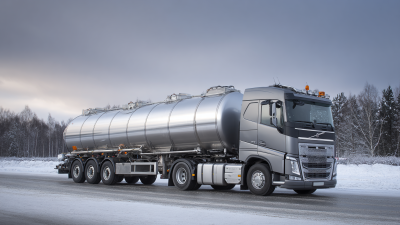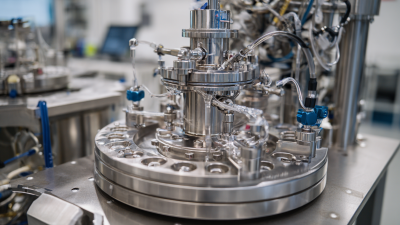
-
Home
-
About us
-
Products
-
Solutions
-
News
-
Blog
-
Contact us
Leave Your Message

The advent of Cryogenic Liquid Transport Vehicles (CLTVs) represents a pivotal innovation in the logistics and supply chain sectors, addressing the growing demand for safe and efficient transportation of cryogenic fluids. As industries ranging from aerospace to healthcare increasingly rely on liquid gases such as oxygen, nitrogen, and hydrogen, the need for advanced transport solutions becomes ever more critical. This paper explores the transformative potential of CLTVs in streamlining logistics, enhancing safety protocols, and minimizing environmental impacts. By leveraging state-of-the-art technologies and innovative engineering designs, cryogenic transport vehicles are poised to redefine efficiency standards while ensuring product integrity during transit. This forward-looking analysis aims to provide insight into the future of cryogenic transport and its implications for global supply chain dynamics.

Innovations in cryogenic liquid transport technologies are pivotal for transforming the supply chain, particularly in the context of hydrogen storage and delivery. Current methods of storing hydrogen can lead to significant energy losses, with up to 40 percent of energy wasted when hydrogen is pressurized or liquefied. This has prompted startups to seek innovative solutions that allow for the storage and delivery of hydrogen at room temperature, thus enhancing efficiency and sustainability within supply chains.

Recent advancements have highlighted the importance of developing new technologies for the storage and management of cryogenic fluids. For instance, methodologies like cryogenic fluid management are being tested to optimize the storage and transfer of super cold fuels, which are critical for various applications, including space missions. Collaborative projects that focus on liquid hydrogen technology are emerging, showcasing the commitment of various enterprises to pioneering sustainable practices in transportation and energy sectors. These innovations are not just transforming how we move cryogenic liquids but are also fundamentally reshaping our approach to sustainable energy logistics.
Cryogenic logistics presents unique challenges that require innovative solutions to ensure efficient transport of liquid gases. One of the primary hurdles is the maintenance of extremely low temperatures during transportation. Any fluctuation in temperature can result in significant losses due to evaporation or product degradation. To combat this, advanced insulation technologies and specialized tank designs are being developed to enhance thermal retention. These innovations aim to minimize heat transfer and maintain stable conditions throughout the supply chain.
Another notable challenge is the complexity of handling cryogenic materials. The risk of equipment failure or human error can lead to hazardous situations, including leaks or accidents. To address this, robust training programs for personnel are essential, ensuring they are well-versed in safety protocols and operational procedures. Additionally, employing automated systems can streamline processes, reducing the likelihood of human errors and improving overall safety in cryogenic operations. By incorporating these strategies, the cryogenic transport sector can enhance its reliability and efficiency, paving the way for broader applications in various industries.
| Dimension | Description | Current Status | Challenges | Potential Solutions |
|---|---|---|---|---|
| Transport Efficiency | Optimizing routes and minimizing loss during transport. | Moderate efficiency with room for optimization. | Time delays and fuel waste. | Utilize AI route optimization tools. |
| Temperature Control | Maintaining required low temperatures during transport. | Varied practices across the industry. | Risk of temperature excursions. | Implement advanced insulation and monitoring systems. |
| Regulatory Compliance | Adhering to safety and environmental regulations. | Compliance efforts vary. | Regulations can be complex and vary by region. | Develop streamlined compliance processes. |
| Cost Management | Managing the cost of cryogenic transport. | High operational costs. | Increasing costs of materials and energy. | Invest in cost-effective technologies and bulk purchasing. |
| Safety Measures | Ensuring safe handling of cryogenic liquids. | Safety standards in place but variable adherence. | Incidents can occur due to improper handling. | Regular training and updates on safety protocols. |
The advent of cryogenic liquid transport vehicles is poised to revolutionize supply chain efficiency across various industries. By utilizing advanced insulation and refrigeration technologies, these vehicles can maintain low temperatures essential for transporting sensitive cargo such as pharmaceuticals, food products, and industrial gases. The ability to operate at cryogenic temperatures reduces spoilage and ensures product integrity, thereby minimizing waste and maximizing value throughout the supply chain.
Moreover, cryogenic vehicles enhance logistical capabilities by allowing for longer transportation durations without compromising quality. This advancement enables businesses to expand their service areas and cater to remote locations, significantly improving market reach. The precise temperature control offered by cryogenic transport not only streamlines inventory management but also aligns with increasing consumer demand for high-quality, fresh products.
As industries strive for greater sustainability, the reliance on efficient cryogenic methods can lead to lower carbon footprints and reduced overall operational costs, making them an indispensable asset in modern supply chain networks.
The integration of cryogenic liquid transport vehicles into the supply chain heralds a significant shift towards more sustainable industrial practices. These vehicles, designed to maintain low temperatures for transporting gases like liquefied natural gas (LNG) and industrial solvents, reduce energy consumption during transportation. This efficiency not only diminishes greenhouse gas emissions but also enhances the overall carbon footprint of industry operations. As businesses seek to meet global sustainability goals, cryogenic transport offers a promising solution.
Tips: Companies considering cryogenic transport should start by assessing their current emissions and explore how adopting such vehicles can align with their environmental strategies. Implementing advanced tracking and optimization technologies can further enhance the efficiency of the supply chain, ensuring that resources are utilized optimally.
Moreover, the sustainability implications extend beyond mere transportation. The use of cryogenic liquids can lead to cleaner production methods, as these substances often lead to fewer byproducts and waste. Industries can leverage this to promote circular economy practices, creating a loop where waste is minimized and resources are reused effectively.
This paradigm shift is essential for achieving long-term sustainability in various sectors.
Tips: Engaging with stakeholders in the supply chain can foster collaboration and innovation, driving further advancements in cryogenic technologies and applications. Regular training and workshops can help teams stay updated on best practices for integrating these vehicles into existing systems.
The cryogenic supply chain is undergoing a significant transformation with the advent of advanced technologies and innovations. As industries increasingly depend on cryogenic liquids for applications ranging from healthcare to aerospace, understanding the future trends in cryogenic supply chain management becomes crucial. Enhanced vehicle designs, better insulation technologies, and real-time tracking systems are paving the way for more efficient transport, ensuring that these temperature-sensitive materials reach their destinations with minimal loss and maximum safety.

Tips for optimizing cryogenic liquid transport include maintaining rigorous temperature control throughout the journey. Implementing smart sensors that monitor and transmit temperature data in real-time can help prevent costly spoilage during transit. Additionally, choosing vehicles that incorporate energy-efficient refrigeration systems can further enhance the sustainability of the supply chain, addressing both regulatory demands and environmental concerns.
Another trend is the integration of automation in cryogenic logistics. Automated handling systems and robotics can improve loading and unloading processes, reducing human error and increasing overall safety. Investing in staff training and efficient operational protocols will ensure that as technologies evolve, personnel remain equipped to handle new systems effectively, maintaining the integrity of the cryogenic liquid during transport.





